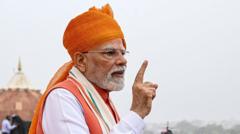How Will Modi’s Call to Boost Spending in India Respond to Trump’s 50% Tariffs?

Published: 2025-08-26 23:42:23 | Category: technology
Indian Prime Minister Narendra Modi has recently promised a significant tax overhaul aimed at boosting the economy, particularly for the common man and small businesses. This initiative includes a proposed reduction in the Goods and Services Tax (GST) and income tax cuts, which could provide much-needed relief amidst global economic challenges.
Last updated: 27 October 2023 (BST)
Key Takeaways
- Modi's proposed tax reforms include a simplification of the GST and income tax cuts.
- The changes aim to stimulate consumer spending, crucial for India's economy.
- Private consumption constitutes nearly 60% of India's GDP, making these reforms vital.
- Analysts predict that these tax cuts could offset potential revenue losses through increased consumer spending.
- India's recent sovereign rating upgrade indicates improved investment prospects.
Understanding Modi's Tax Bonanza Proposal
In a series of public addresses, Prime Minister Narendra Modi has articulated his vision for a "massive tax bonanza" aimed at invigorating India's economy. This initiative comes as a response to both domestic economic challenges and external pressures, such as the impending tariffs imposed by the United States. By proposing a significant overhaul of the indirect tax system, Modi is attempting to ease the financial burden on citizens and small businesses, which are crucial for the economic landscape of India.
The Current Economic Landscape
India's economy has been under pressure, particularly from the effects of the COVID-19 pandemic, which has resulted in job cuts and stagnating wages, particularly in urban areas. Despite a strong rural economy bolstered by good harvests, urban demand has been sluggish. The proposed tax reforms seek to address these challenges by putting more disposable income into the hands of consumers, thereby stimulating demand and economic growth.
The Proposed GST Reforms
The Goods and Services Tax (GST) was introduced in India eight years ago to streamline the taxation process by replacing a complex array of indirect taxes. However, experts have argued that the current GST structure is overly complicated, with numerous thresholds and exemptions that hinder compliance and increase the cost of doing business.
Modi's government has now proposed a simplified two-tier GST system, which aims to make it easier for businesses to comply and for consumers to understand. This reform is seen as crucial for enhancing the overall economic environment in India.
Potential Impact on Consumer Spending
Private consumption is a major contributor to India's GDP, accounting for nearly 60%. With the proposed tax cuts, analysts believe there could be a significant increase in consumer spending. Investment banking firm Morgan Stanley suggests that these fiscal measures could enhance GDP growth while simultaneously reducing inflation, creating a more stable economic environment.
Moreover, sectors that are expected to benefit the most from these reforms include consumer goods like scooters and small cars, as well as construction materials like cement. These industries typically see an uptick in demand around festive seasons such as Diwali, making the timing of these reforms particularly opportune.
Analysts' Perspectives on the Tax Bonanza
Analysts from various financial institutions, including Jeffries and UBS, have weighed in on the potential effects of Modi's tax proposals. They assert that while there may be an initial revenue loss due to lower GST rates, this could be offset by increased consumer spending and higher tax collections in other areas.
Furthermore, the expected "multiplier effect" of these tax cuts could lead to a more substantial boost in consumption compared to previous corporate tax cuts, which primarily benefited businesses. This could, in turn, create a positive feedback loop, stimulating further economic activity and job creation.
Interest Rates and Government Employment
Alongside the tax proposals, there are indications that the Reserve Bank of India may consider further interest rate reductions in response to these fiscal measures. With previous cuts of 1% already implemented, a further decrease would likely enhance lending conditions and encourage additional consumer spending.
Additionally, the government plans to increase salaries for approximately half a million employees, which should further support economic growth by increasing disposable income among a significant portion of the population.
The Broader Economic Context
Despite these positive developments, India faces significant external economic challenges. The global geopolitical landscape remains tumultuous, particularly with ongoing tensions with the United States over trade policies and energy purchases from Russia. The recent 50% tariff rate imposed by the US is particularly concerning, as it threatens to disrupt India's export-driven industries.
Experts describe these tariffs as akin to a trade sanction, which could have far-reaching implications for India's growth prospects. The cancellation of upcoming trade negotiations between the two nations has further complicated an already fragile situation.
Recent Upgrades and Future Outlook
In a glimmer of hope amidst these challenges, India recently received a rare sovereign rating upgrade from S&P Global, its first in 18 years. This rating reflects increased confidence in India's economic management and could potentially lower borrowing costs for the government, enhancing foreign investment flows.
However, even with these reforms and positive ratings, the overall growth rate of the Indian economy has slowed significantly from previous highs of around 8%. Indicators suggest that while the government is taking steps to address these challenges, considerable uncertainty remains.
Conclusion
Prime Minister Modi's proposed tax reforms represent a significant step toward revamping India's economic landscape. By focusing on reducing the GST and implementing income tax cuts, the government aims to stimulate consumer spending and support the economy amid global challenges. The success of these initiatives, however, will depend on navigating external pressures and ensuring that the domestic economy can sustain growth in the coming months.
As India moves forward with these reforms, it will be crucial to observe how these changes impact consumer behaviour and overall economic stability. Will these tax cuts be enough to reignite growth, or will external challenges continue to impede progress? Only time will tell. #MakeInIndia #GSTReform #EconomicGrowth
FAQs
What is the proposed tax bonanza by Modi?
The proposed tax bonanza refers to significant tax reforms by Prime Minister Modi, including reductions in the Goods and Services Tax (GST) and income tax cuts aimed at boosting consumer spending and supporting small businesses.
How will the GST reforms impact consumers?
The GST reforms aim to simplify the tax structure, making it easier for consumers and businesses to understand and comply. This simplification could lead to lower prices and increased consumer spending.
What are the expected benefits of the tax cuts on the economy?
Experts anticipate that the tax cuts will stimulate private consumption, which constitutes nearly 60% of India's GDP. This increase in spending could boost economic growth and help mitigate inflation.
How do external factors influence India's economic growth?
External factors, such as global trade relations and geopolitical tensions, can significantly impact India's economic growth. Recent tariffs imposed by the US on Indian goods could disrupt exports and affect overall economic stability.
What does a sovereign rating upgrade mean for India?
A sovereign rating upgrade signals increased investor confidence in India's economic management. It can lower government borrowing costs and improve foreign investment, which is crucial for economic growth.



